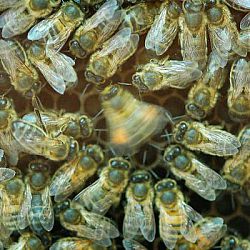Dancing bees reveal why summer isn’t the season of plenty
Summertime and the living is easy, we’re told – but it’s not so for the hungry honey bee, new research from the University of Sussex published this week (Wednesday 2 April) reveals.
 A honey bee waggle dances for nest mates in the hive
A honey bee waggle dances for nest mates in the hive
Researchers from the Laboratory of Apiculture and Social Insects (LASI) spent two years filming honey bees in the lab’s glass-fronted observation hives and then decoding their waggle dances to discover how far the bees were having to fly to find sources of food during different seasons.
The bees were able to access the surrounding downland countryside and the nearby city of Brighton and Hove via tube tunnels that opened to the outside of the lab.
The waggle dance is a unique behaviour found in honey bees, which a returning forager bee performs in the hive to tell its nest mates where to find good sources of pollen and nectar. The dance (in which the bee waggles its abdomen while moving in a figure-of-eight pattern) indicates the distance to a patch of flowers from the hive and the direction from the hive.
By examining the waggle dance data, the researchers found that in summer, honey bees were covering areas 22 times greater than in spring and six times greater in the autumn.Honey bees are savvy foragers and will not waste valuable time and energy travelling if they don’t need to, so the results show that summer is the most challenging season for collecting the nectar and pollen from flowers that bees use for food.
The study, published in the journal PLOS One, concludes that:
- The seasonal variation in distance, when the bees are flying the furthest in the summer, is not because they are necessarily collecting better quality resources or because it is warmer;
- The honey bee is only one of many species of flower-visiting insects, but the results are relevant to other species because the honey bees is a generalist forager that visits many types of plants to collect nectar and pollen. If food is harder to find for honey bees, it will be harder for other species;
- In spring there are many flowers from dandelions to tree blossoms, and in autumn, there is ivy, a very common plant that blooms in September and October. Summers represent a period of seasonal foraging dearth;
- Summer is probably a harder season both because there are fewer flowers but also because there are more insects active at that time, competing with each other for nectar and pollen.
The results, say the researchers, can be used to focus efforts to help bees better. Bees fare worse in summer partly because agricultural intensification means that there are fewer suitable summer wild flowers in the countryside for bees. The research findings could therefore be used to better inform government and private initiatives to increase available bee forage and to create recommended lists of garden flowers that grow in the greatest time of need (ie, the summer) and that are suitable for bees and other pollinators.
Dr Margaret Couvillon, who led the research, says: “We eavesdropped on what the bees were communicating to each other about where to find good food. What they told each other shows that they are finding it harder to find food in the summer than in the spring or autumn.
“In any conservation work, it is important to know where the animal collects its food. Some researchers attach tracking devices to the animals they study, which we cannot do because the honey bees are too small. But we also don’t have to because the honey bee is the only animal that tells you directly where it has collected food.”
Professor Francis Ratnieks, who supervised the study, says: “The honey bee dance language was one of the most unexpected scientific discoveries of the 20th century. In 1973 the discoverer, Austrian scientist Karl von Frisch, was awarded a Nobel Prize for the discovery. It’s good to be following his lead, and using this amazing behaviour to help bees.”
